When it comes to roofing ideas for pergolas, the options are as diverse and innovative as your imagination allows. As an outdoor structure designed to provide shade and create a comfortable space, selecting the right pergola is essential in maximizing both aesthetics and functionality. In this blog post, we will explore various roofing ideas for pergolas that cater to different preferences and needs.
We will discuss retractable and louvered roofs which offer flexibility in sun protection while also enhancing your outdoor experience. Additionally, we’ll delve into living roofs with climbing plants that bring natural beauty and environmental benefits to your backyard oasis.
For those seeking more traditional materials, we’ll examine glass or plastic covers along with wooden structures commonly used in pergola designs. Finally, we’ll introduce fabric tension systems such as ShadeFX retractable canopies that add style without compromising durability or performance.
To ensure proper water management within these outdoor spaces, our discussion will also include integrating gutter systems seamlessly into various types of pergolas. Join us on this journey through creative roofing ideas for pergolas!
Table of Contents:
- Retractable and Louvered Pergola
- Benefits of Retractable Pergolas
- Advantages of Louvered Roof Systems
- Living Roofs with Climbing Plants
- Glass and Plastic Covers for Pergolas
- Wooden Structures in Pergola Designs
- Fabric in Tension Systems and Retractable Canopies
- Gutter System Integration with Pergolas
- FAQs in Relation to Roofing Ideas for Pergolas
- Roofing Ideas for Pergolas – A Recap
Retractable and Louvered Pergolas
Innovative roofing ideas for pergolas include retractable roofs that provide flexibility by allowing you to open up your outdoor area when desired while still offering protection against sun exposure, heavy winds, and rainfall. Louvered roofs promote air circulation through adjustable slats which can be angled according to personal preference for optimal shade levels throughout different times of day or seasons.
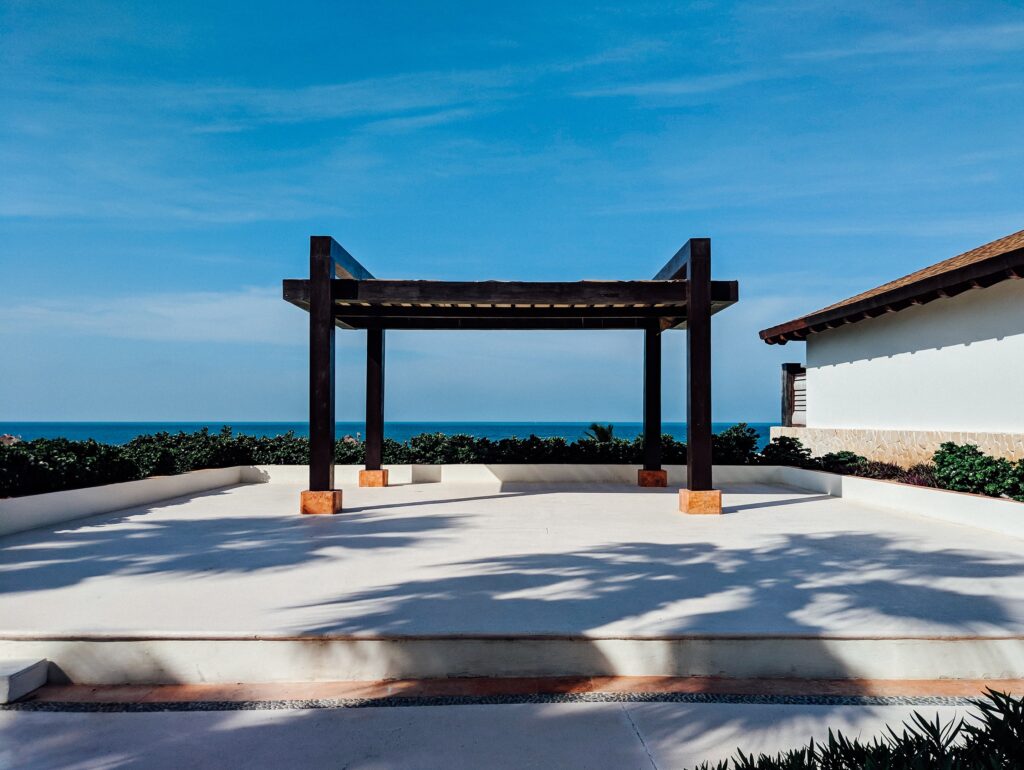
Benefits of Retractable Pergola
Retractable pergolas are a popular choice among homeowners looking to maximize their outdoor areas. These versatile systems offer several advantages:
- Fully customizable designs cater to individual preferences and requirements.
- The ability to quickly adjust the roof’s position allows for better control over sunlight penetration, ensuring comfortable temperatures in your backyard pergola.
- Durable materials like aluminum or stainless steel ensure long-lasting performance with minimal maintenance required.
- Ease of installation makes it an ideal option for DIY enthusiasts as well as professional contractors alike.
Advantages of Louvered Roof Systems
Louvered roof systems have gained popularity due to their unique design features that enhance both functionality and aesthetics in any structure outdoor. Some notable benefits include:
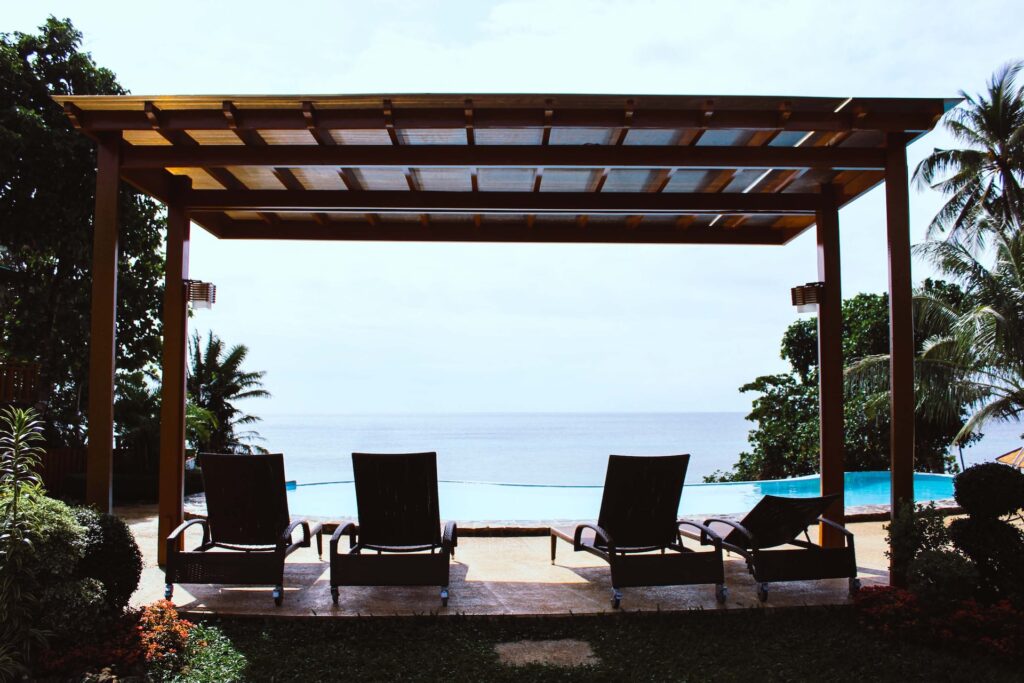
- Adjustable louvers allow users complete control over light filtration and ventilation, creating a more comfortable environment beneath the pergola canopy during hot summer days or cooler evenings.
- Constructed from durable materials like aluminum or wood, louvered roofs can withstand harsh weather conditions and require minimal maintenance.
- The sleek design of a louvered roof system complements both modern and traditional architectural styles, adding visual interest to your outdoor areas.
Incorporating retractable or louvered pergola into your outdoor area not only enhances the overall aesthetic appeal but also provides increased functionality. By offering protection from the sun, while allowing for easy adjustments according to personal preferences, these innovative roofing options are perfect for those looking to create a comfortable and inviting backyard oasis. With various designs available in the market today, it’s easier than ever before to find the perfect pergola solution that suits your needs and style preferences.
Explore more about these systems by visiting reputable online resources such as Myrooff.com or consulting with professional contractors who specialize in designing custom structures outdoor tailored specifically for you.
Retractable and louvered pergola roofs offer an array of benefits, from providing shade to allowing for more natural light when desired. For a unique look, consider adding roof (living) elements with climbing plants such as ivy or jasmine to your pergola design.
Key Takeaway:
Retractable and louvered roofs are innovative roofing ideas for pergolas that offer flexibility, protection against weather elements, and air circulation. Retractable roofs allow for better control over sunlight penetration while louvred roofs provide complete control over light filtration and ventilation. Both options enhance the overall aesthetic appeal of outdoor living areas while providing increased functionality.
Living Roofs with Climbing Plants
A more eco-friendly approach to pergola involves using climbing plants and vines on your pergola structure. These living roofs not only create visual interest but also provide shade while improving air quality around them due to their natural ability to filter pollutants out of the atmosphere. This type of “living” greenery-covered rooftop has gained popularity among homeowners looking for unique environmentally friendly solutions for enhancing backyard spaces.
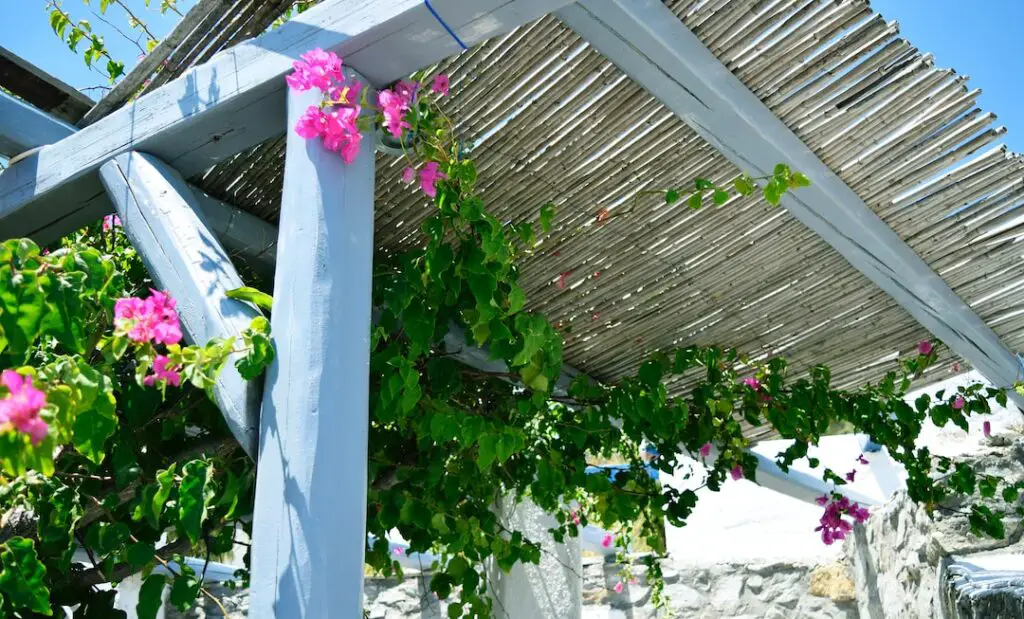
Popular Climbing Plants for Living Pergolas
- Clematis: Known for its beautiful flowers, clematis is a popular choice as it can grow quickly and comes in various colors.
- Roses: Climbing roses add elegance and fragrance to any outdoor area, making them an excellent option for creating a romantic ambiance.
- Jasmine: With its sweet scent and delicate white flowers, jasmine provides both beauty and aroma when used as a living roof covering.
- Grapevines: Not only do grapevines offer shade, but they also produce fruit that you can enjoy during harvest season.
- Ivy: As one of the most robust climbers available, ivy creates dense coverage ideal for those seeking maximum protection from the sun from their pergola roof.
Maintenance Tips for a Thriving Living Roof
- Select Appropriate Plant Species: Choose climbing plants suitable for your climate zone and soil conditions so they will thrive in your specific environment.
- Create Proper Support: Ensure your pergola structure is strong enough to support the weight of climbing plants and provide adequate space for them to grow.
- Prune Regularly: Regular pruning helps maintain a healthy growth pattern, keeps the plant under control, and encourages flowering or fruit production.
- Fertilize Appropriately: Provide necessary nutrients by applying organic compost or slow-release fertilizers according to each plant’s specific needs.
- Water Wisely: Monitor soil moisture levels and water as needed based on local climate conditions and individual plant requirements. Overwatering can lead to root rot, while underwatering may cause wilting or stunted growth.
Incorporating living roofs with climbing plants into your pergola roof ideas not only enhances the beauty of your outdoor area but also contributes positively towards environmental sustainability. With proper care and maintenance, these natural coverings will transform your backyard pergola into an inviting oasis that offers both protection from the sun and improved air quality for you to enjoy all year round.
Living roofs with climbing plants are an attractive and low-maintenance way to add a lush, natural touch to any pergola. However, glass and plastic covers offer more protection from the elements while still allowing in light for a bright outdoor area.
Key Takeaway:
Create an eco-friendly pergola by using climbing plants and vines, which not only provide shade but also improve air quality. Popular plant options include clematis, roses, jasmine, grapevines, and ivy. To maintain a thriving living roof, choose appropriate plant species for your climate zone and soil conditions; create proper support; prune regularly; fertilize appropriately; and water wisely.
Glass and Plastic Covers for Pergolas
Transforming outdoor areas with transparent or translucent glass or plastic coverings allows natural light penetration without sacrificing protection against the elements. These options are typically lightweight, affordable, easy to install, and maintain compared to other traditional materials like wood or metal. Let’s explore some of the popular types of glass covers suitable for pergolas and discuss the pros and cons of plastic covers.
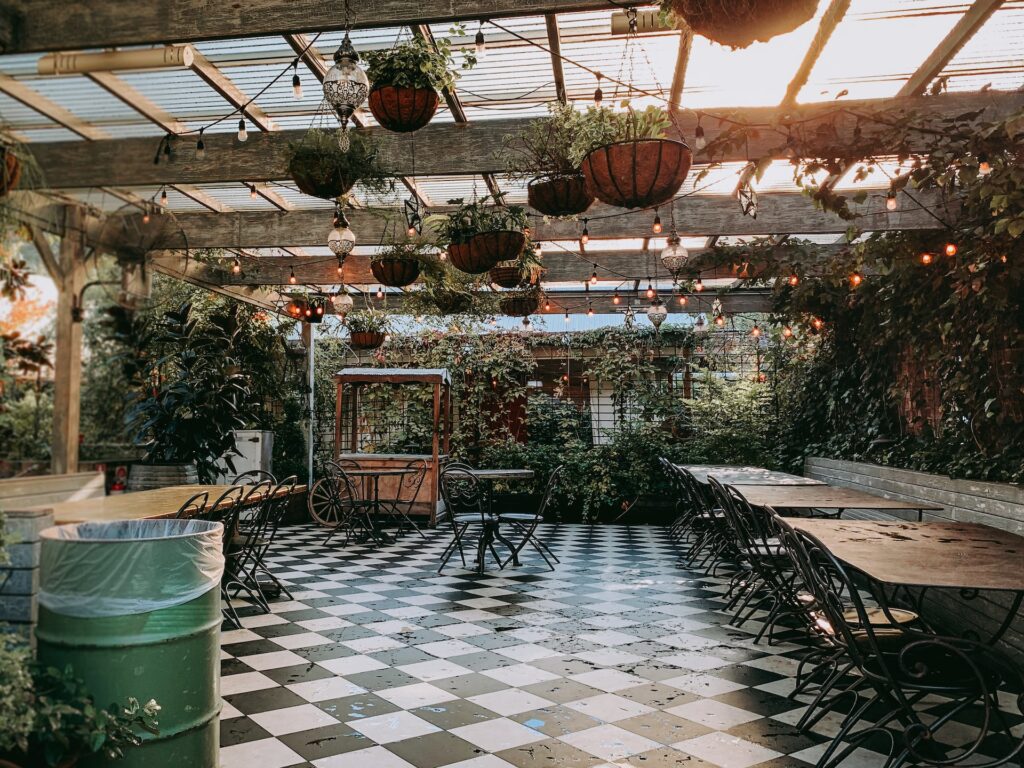
Types of Glass Covers Suitable for Pergolas
- Laminated Glass: This type is composed of two layers sandwiched together by a thin layer of polyvinyl butyral (PVB). It offers excellent durability, sound insulation properties, and resistance to breakage due to its unique construction. Learn more about laminated glass here.
- Toughened Glass: Also known as tempered glass, this option undergoes a special heat treatment process that makes it up to five times stronger than regular annealed glass. Its increased strength ensures better safety in case it breaks since it shatters into small granular pieces instead of sharp shards. Read more about toughened glass on this informative article.
- Solar Control Glass: Ideal for regions with intense sunlight exposure throughout the year; solar control glasses have special coatings that help reduce heat transmission while allowing ample natural light inside your outdoor area – perfect balance between comfort energy efficiency purposes alike. Check out these benefits at our recommended source: Pilkington Suncool Range.
Pros and Cons of Plastic Covers
Plastic covers, such as polycarbonate or acrylic sheets, are another popular choice for pergola due to their affordability and ease of installation. Here are some pros and cons to consider when selecting plastic covers for pergola:
Glass and plastic covers are both excellent options for pergola, depending on the style you’re looking to achieve. Still, if a more classic look is desired, then wooden structures may be the ideal choice.
Wooden Structures in Pergola Designs
The classic appeal of wooden structures brings warmth and character to any setting, blending seamlessly with various architectural styles and designs. Whether you prefer a modern, rustic, contemporary, or classic look for your pergola, wood offers excellent insulation properties that help keep temperatures cooler during hot summer months and warmer during colder winter periods. This reduces energy consumption costs associated with heating and cooling systems in homes and businesses alike.
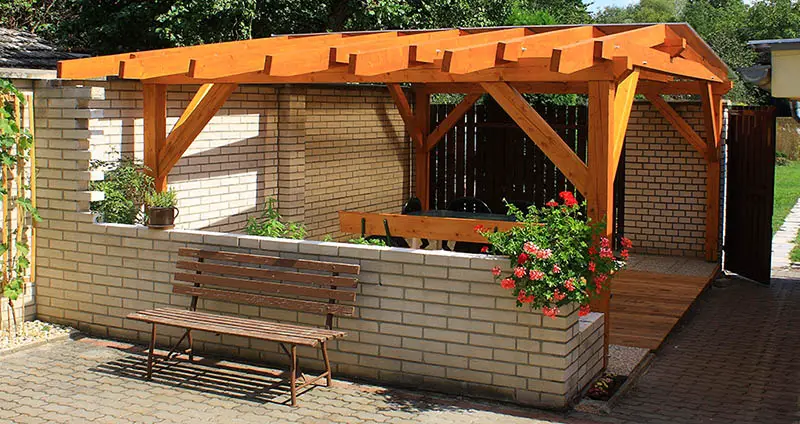
Choosing the Right Wood for Your Pergola
Selecting the appropriate type of wood is crucial when designing your wooden pergola. Some popular choices include cedar, redwood, pressure-treated pine, and teak. Cedar is naturally resistant to decay while redwood boasts durability against rotting.
Pressure-treated pine has added protection from insects due to its chemical treatment process; however, it may require more maintenance over time compared to other options like teak, which is known for its weather resistance capabilities.
- Cedar: Naturally resistant to decay.
- Redwood: Durable against rotting.
- Pressure-Treated Pine: Insect-resistant but requires more maintenance.
- Teak: Weather-resistant option ideal for outdoor use.
Tips for Maintaining Wooden Pergola Structures
To ensure the longevity of your wooden pergola structure as part of your beautiful backyard oasis or functional outdoor area complete with comfortable outdoor furniture, proper maintenance is essential. Here are some tips to help you care for your wood pergola:
- Regular Cleaning: Remove dirt, debris, and mildew by using a soft brush or cloth with a mixture of water and mild detergent.
- Sealing: Apply a high-quality sealant to protect the wood from moisture damage and sun exposure. This should be done every few years depending on the type of wood used in your pergola construction.
- Pest Control: Inspect your outdoor structure regularly for signs of insect infestation or rotting; if detected early enough, these issues can be addressed before they cause significant damage.
Incorporating wooden structures into your pergola design not only enhances its aesthetic appeal but also provides excellent insulation properties that contribute to energy efficiency within indoor spaces. By selecting the correct type of timber and keeping up with proper upkeep, you can relish in a lasting, attractive addition to your exterior area that gives both form and function while delivering necessary sun coverage during hotter seasons.
Wooden structures in pergola designs provide a strong and reliable base for the structure, while also adding aesthetic value to any outdoor area. Moving on from this point, fabric tension systems and retractable canopies offer further benefits of convenience and versatility.
Key Takeaway:
Wooden structures are a popular choice for pergola designs due to their insulation properties and aesthetic appeal. Choosing the right type of wood, such as cedar or teak, is crucial for durability and resistance against decay or insects. Regular maintenance through cleaning, sealing, and pest control can ensure the longevity of your wooden pergola structure.
Fabric in Tension Systems and Retractable Canopies
For a more flexible approach to shade, consider fabric in tension systems or ShadeFX retractable canopy systems mounted under rafters with rope operation. These innovative solutions provide sun protection while allowing you to adjust the level of coverage as needed throughout the day.
Benefits of Fabric in Tension Systems
- Versatility: Fabric in tension systems can be customized to fit any outdoor structure, including pergolas, making them an ideal choice for those looking for unique pergola roof ideas.
- Durability: High-quality fabrics used in these systems are designed to withstand harsh weather conditions such as heavy winds and rainfall, ensuring long-lasting performance.
- Maintenance: The fabric is easy to clean and maintain compared to other materials like wood or metal roofing options. This makes it a popular choice among homeowners who want minimal upkeep requirements for their outdoor living space.
- Aesthetics: Available in various colors and patterns, fabric tension systems add visual interest and style that complements your existing outdoor furniture and decor elements seamlessly.
Features of ShadeFX Retractable Canopies
The ShadeFX retractable canopy system offers several advantages over traditional fixed-roof pergolas. Some key features include:
- Sun Protection: This system provides effective protection from the sun by blocking up to 80% of harmful UV rays when extended, ensuring a comfortable outdoor area for you and your guests.
- Flexibility: With the ability to retract or extend the canopy as needed, homeowners can easily control the amount of shade provided in their outdoor living area. This makes it perfect for those who want to enjoy both sunny and shaded areas within their pergola (backyard).
- Customization: ShadeFX canopies are available in various fabric options, colors, and patterns that allow you to personalize your pergola according to your preferences and design aesthetic.
- Rain Protection: The water-resistant fabric used in these systems helps protect against light rain showers while still allowing air circulation beneath the canopy. This ensures a pleasant atmosphere even during unpredictable weather conditions.
Incorporating fabric tension systems or retractable canopies into your pergola design not only enhances sun protection but also adds an element of style and functionality that elevates your outdoor area experience. Explore different materials, colors, and patterns when selecting a system that best suits your needs and preferences.
Fabric in tension systems and retractable canopies offer a variety of benefits, such as energy savings and increased outdoor living space. With the right components, gutter system integration with the pergola is possible to ensure seamless installation and maintenance.
Key Takeaway:
Fabric in tension systems and retractable canopies are innovative solutions for providing sun protection while allowing you to adjust the level of coverage as needed throughout the day. They offer versatility, durability, low maintenance requirements, and aesthetic appeal that complements your existing outdoor furniture and decor elements seamlessly. Incorporating these systems into your pergola design enhances sun protection while adding an element of style and functionality that elevates your outdoor area experience.
Gutter System Integration with Pergolas
Integrating a well-designed gutter system into your pergola is essential for managing rainwater runoff effectively without compromising aesthetics. This not only protects your outdoor area from water damage but also enhances its visual appeal by seamlessly blending with the structure’s design. In this section, we will look into the components necessary for an efficient gutter system and give advice on how to integrate it seamlessly and maintain it.
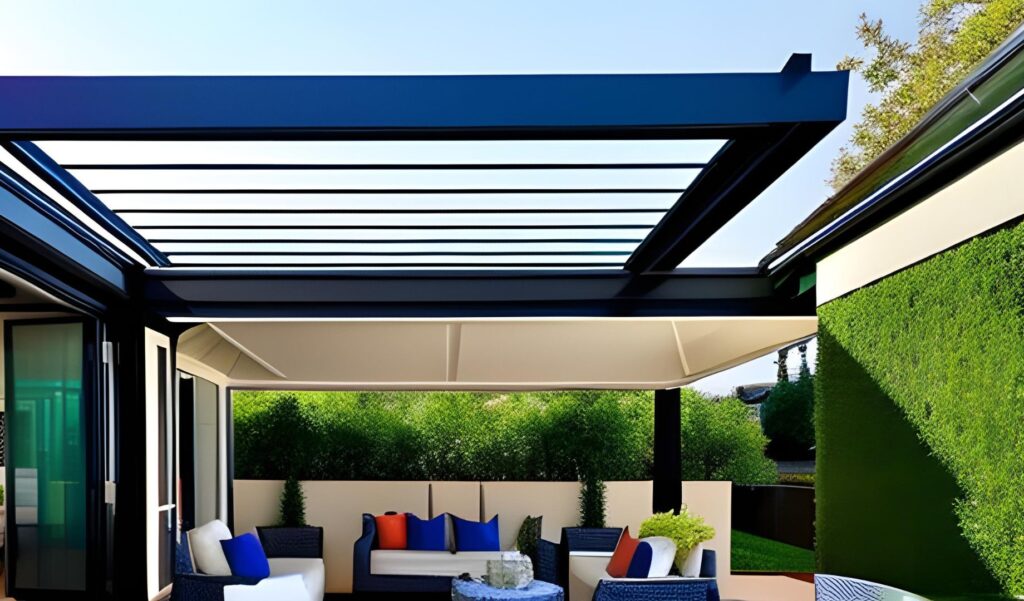
Essential Components of an Effective Gutter System
- Gutters: These are horizontal channels that collect rainwater from the roof surface and direct it towards downspouts. Gutters come in various materials such as aluminum, copper, steel, or vinyl to match your pergola roof ideas.
- Downspouts: Vertical pipes connected to gutters that carry water away from the foundation of your structure outdoor.
- Hangers: Brackets used to support gutters along their length while maintaining proper slope for efficient drainage.
- Caps/Ends: Fittings placed at each end of a gutter run to prevent debris entry and maintain a clean appearance.
- Gutter guards/screens: Optional accessories installed over gutters to minimize clogging caused by leaves, twigs, or other debris.
Tips for Seamless Integration and Maintenance
- Select appropriate materials: Choose gutter systems made from durable, low-maintenance materials that complement your wood pergola or other structure outdoor. For instance, aluminum gutters are lightweight and rust-resistant, making them an excellent choice for most climates.
- Match the style: Opt for gutter profiles (e.g., half-round or K-style) that harmonize with your pergola’s architectural design to create a cohesive look.
- Ensure proper installation: Properly installed gutters should have a slight slope towards downspouts to facilitate water flow. Additionally, secure hangers at appropriate intervals to prevent sagging over time.
- Maintain regularly: Clean gutters and downspouts at least twice a year – more frequently if you have nearby trees shedding leaves onto your pergola (backyard). Inspect hangers and other components periodically for signs of wear or damage and replace as needed.
Incorporating an efficient gutter system into your pergola is crucial in protecting both the structure itself and its surrounding area from potential water damage. By selecting suitable materials, ensuring proper installation, and performing regular maintenance checks, you can enjoy all the benefits of having an attractive yet functional outdoor space without worrying about rainwater runoff issues.
Key Takeaway:
To effectively manage rainwater runoff from your pergola, it is essential to integrate a well-designed gutter system. The components of an effective gutter system include gutters, downspouts, hangers, caps/ends and optional gutter guards/screens. Selecting appropriate materials that match the style of your structure outdoor and performing regular maintenance checks are crucial for seamless integration and efficient water flow management.
FAQs in Relation to Roofing Ideas for Pergolas
What is the Best Roofing Option for a Pergola?
The best roofing option for a pergola depends on your preferences, budget, and location. Retractable roofs offer flexibility and control over sunlight exposure, while living roofs with climbing plants provide natural shade and beauty.
Glass or plastic covers protect from rain without blocking light, wooden structures add traditional charm, and fabric in tension systems are lightweight yet durable. Consider factors like maintenance requirements and weather conditions when choosing.
What is the Best Material to Cover a Pergola?
The ideal material to cover a pergola depends on your needs: retractable canopies offer versatility; polycarbonate sheets provide UV protection; glass adds elegance but may require cleaning; wood offers durability but requires regular maintenance; fabric in tension systems are easy to install but may need replacement after some years. Assess factors such as climate, aesthetics, functionality, and upkeep before deciding.
Should I Put a Roof on My Pergola?
A roofed pergola provides shade from sunrays during hot days or shelter during rainy seasons while still allowing air circulation. If you want more comfort outdoors without completely enclosing the space like an enclosed patio would do – adding a roof might be beneficial for you.
However, if you prefer an open-air structure that allows maximum sunlight penetration – keeping it unroofed might suit better.
How Do You Support a Pergola to a Roof?
To support a pergola attached to your house’s roof, use brackets or ledger boards securely fastened into wall studs or rafters of the existing structure. For freestanding pergolas, ensure the posts are anchored in concrete footings or secured with metal post bases. Consult a structural engineer or experienced contractor to ensure proper load-bearing capacity and safety.
What is a Pergola with a Roof Called?
A pergola with a roof is often referred to as a “gabled” or “pitched” pergola if it has an angled structure resembling traditional house roofs. Alternatively, it may be called a covered pergola when featuring flat roofing materials like polycarbonate sheets, glass panels, fabric canopies, or wooden slats.
Roofing Ideas for Pergolas – A Recap
When it comes to roofing ideas for pergolas, there are a variety of roofing options available, ranging from traditional gutter systems and retractable roofs to modern living green roofs. From gutter systems and retractable roofs to living green roofs and modern innovations, the possibilities are endless. Each option has its own unique benefits and considerations, so it’s important to do your research before making a decision.
Whether you’re building your own roof or working with a professional contractor, understanding the pros and cons of each option can help you make an informed choice that meets your needs and budget. By researching roofing materials, designs and maintenance tips to suit your needs, you can create a functional and aesthetically pleasing outdoor space.
If you’re looking for more inspiration or guidance on roof ideas for pergolas, head over to MyRoof. They offer expert advice on all things related to pergolas, backyard pergolas, wood pergolas, outdoor areas, structure and furniture, and more.
Hi, I’m Jim. I was a roofing constructor for 20 years, before deciding to start myrooff.com and gather the best content about roofing. I love woodworking and construction and it was only natural for me to start this passion project of mine. Thank you for visitng.

